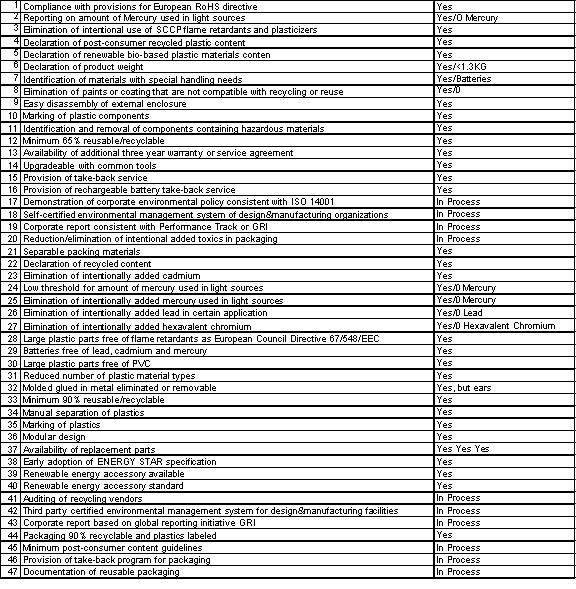Green Machine
Image:Support-banner-square.png|173px|community support pages rect 0 0 135 204 [1] rect 135 0 345 204 Support FAQ rect 0 205 135 408 [2]
- Comment : there's some whitespace here:
rect 135 205 345 408 Other support
- maybe desc none is better. testing.
desc none
</imagemap>
Overview
... the typical laptop runs 20, 30, 40 watts, but when power is a real premium -- which it is for most of these kids and actually most schools even in the developed world -- we designed a laptop that runs on average two watts. So it brings it down within the realm of things like human-generated power, and solar. We have a very robust system for powering the laptop so that it will survive sort of a dirty 35-year-old truck engine generator ... - Walter Bender, OLPC President of Software and Content
The XO by One Laptop per Child (OLPC) is not just visually green, it’s the most eco-green laptop ever made. Many would have you believe that buying “green” will cost more. This is true, for example, for hybrid cars. OLPC was unwilling to increase the price to go green, instead we concentrated on low-cost, low-power, long-life, and field repair and in so doing have created a stunningly green laptop.
In 2007, OLPC received the first “gold” award ever given to a laptop by EPEAT, an organization that assesses the environmental impact of laptops according to the IEEE 1680-2006 specification. XO is also non-toxic and fully recyclable, and our manufacturer has a full take-back program. In other words: these machines are not destined for landfills at the end of their approximate 5 year lifetime -- 2X the lifetime of a typical laptop.
If all computer users switched from their desktops and laptops to the OLPC XO laptop: $9B US dollars could be saved in world-wide electricity bills. This savings is enough to outright buy laptops for 50 million children. In addition, manufacturers would avoid using 50 million barrels of oil, and emitting 65 million metric tons of environmental CO2. The carbon-offset dollars for electricity use alone would be another ~$500 million each year.
Power Consumption
(NEW: see August 2010's blog post including XO-1 and XO-1.5 power measurements, thanks to OLPC's Richard Smith)
Power consumption data for 132 desktop computers and 93 notebook computers which were averaged and used in this analysis. As of 2009, the average desktop computer idles at 80 Watts while the average laptop computer idles at 20 Watts. In contrast, the average idle power consumption of the XO laptop is just 1 watt (with minimal backlight and while not charging).
If the industry adopted a lower power consumption architecture like that created for the OLPC XO, energy usage would go down considerably whilst convenience of use due to batteries lasting longer would go up.
The XO allows human power recharge, as well as solar-, wind-, or other sustainable forms of power input. At $0.10 per kilowatt-hour the savings of a massive switch to an XO or an XO like architecture amounts to a $8.5 billion dollar energy savings. And at 1700 kilo-watt hours per barrel of oil: 50M barrels, and 65 million metric tons of CO2 emissions or another approximately $500M yearly in carbon-offset dollars.
IEEE 1680 Consumer Electronics Environmental Impact
EPEAT has created a procurement tool to help evaluate, compare and select desktop computers, notebooks and monitors based on their environmental attributes. EPEAT provides a clear and consistent set of performance criteria for the design of products, and provides an opportunity for manufacturers to secure market recognition for efforts to reduce the environmental impact of their products. OLPC is in process of applying for a rating, which we believe will be excellent. XO appears destined to be the first laptop to receive their Gold Rating, it has even been suggested that the XO may warrant establishing a new, even higher rating. XO achieves the following which should give it the first gold award:
Notably - above and beyond the EPEAT requirements, XO has
- Batteries that last 4x longer than standard rechargeable
- Power consumption at about 10% of typical laptop
- Laptop lifetime of about 2.5x longer than typical (5 year life)
- Half the size and weight of a typical laptop
Thus, above and beyond EPEAT, in our first year of deployment of 3–5M units we will save, when compared to any other EPEAT ranked laptop shipped in the same year, the following:
- 45-million pounds of e-waste (3 lbs x 5 Munits x 2.5–4x lifetime/2000 lbs/ton)
- 240-Giga-Watt hours of energy (20 Watt extra x 8 hours x 300 days x 5M units)
As we scale in our second year of production these savings should increase even more: to preventing as much 500-million pounds of e-waste, and saving 2.5 Tera-watts of power. OLPC is working with other organizations to assure its environmental impact is very low and more information will be available here in the coming weeks.
Power
Because the XO has flash memory rather than a harddrive, there is no need for a cooling fan, and the power draw is low.
The XO draws on average two watts off power and does not exceed fifteen watts. A typical PC laptop draws 20, 30, 40 or more watts, and a standard US incandenscent buld draws 60 watts.
The battery can be recharged in about 2 hours, and can power the XO for 4~10 hours (depending on the laptop usage). The laptop can take a DC input ranging from 5 volts to 25 volts to charge the 5-cell NiMH battery inside. This is far more flexible than most portable devices. Polarity is positive (+) center pin and negative (-) outer. Reversing the connection will not harm the XO, but neither will it charge. The plug is 5.5mm x 1.75mm (5.5mm X 2.1mm is more common).
References
IBM developerWorks Interviews: Walter Bender on One Laptop Per Child - 24 Apr 2007

